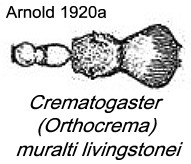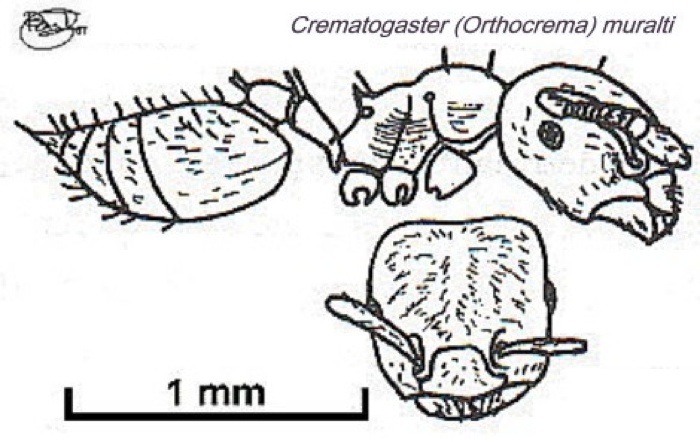Crematogaster (Orthocrema) muralti Forel
  Type location Cameroun
(Cremastogaster Muralti, n. sp., Forel, 1910e: 432, worker) L V
Muralt Type location Cameroun
(Cremastogaster Muralti, n. sp., Forel, 1910e: 432, worker) L V
Muralt
junior synonym (here)
livingstonei (Crematogaster
(Orthocrema) Muralti For., stirps Livingstonei, n. sp., Santschi,
1919a: 344,
worker) from Zambia, Livingstone, G Arnold - see below
worker only described (see Bolton, 1995)  . .
NOTE - I have elevated the smaller, dark brown to
black
form regarded as subspecies ugandensis (Santschi, 1914b: 99,
worker) from Uganda, to species status - Crematogaster
ugandensis.
|
 Forel's
(1910e) description is at Forel's
(1910e) description is at  . Santschi's (1919a)
description of livingstonei is at . Santschi's (1919a)
description of livingstonei is at  . Arnold (1920a: 536)
gave an illustrated translation; this is at . Arnold (1920a: 536)
gave an illustrated translation; this is at  . .
Santschi (1935a) also saw workers of muralti
from Kasai, Dumbi; Ngombe and Kunungu, Zaïre; all collected by
Dr H Schouteden.
|

Crematogaster (Orthocrema) species 1 - Nigeria
specimens (Taylor, 1979: 21). WORKER. TL 2.18 mm, HL 0.61, HW 0.59, SL
0.39, PW 0.34
Colour dark orange, very dark on the gaster. Moderately abundant
pilosity. Erect hairs clavate, this is especially noticeable on the
pedicel. Alitrunk profile a nearly continuous convex curve, with only a
slight depression at the metanotal groove. The propodeal spines are
short, triangular, upturned denticles. The subpetiolar spine is
moderately long and triangular.
The presence of a subpetiolar spine confounds the key of
Bolton (unpublished, 1969) to CRIN species; the clavate hairs, however,
seem unique.
Nests under bark, in dead branch ends and in mummified
pods. In Nigeria, it was not infrequently found on cocoa, on up
to 1% of trees, often in association with Oecophylla longinoda,
and foraging over a surprisingly wide area of canopy (Taylor, 1977). It
constructs discrete tents of vegetable debris over Pseudococcids at the
pod-stalk junction, the tents have been found to be sources of cocoa
black pod disease. Also found on native shrubs and trees, and on kola.
Possibly the same (unnamed) species was mentioned by
Strickland (1951a) from Ghana and Togo. He described
it as being rare and of minor importance, but it was found also on
several other shrubs and trees.
|